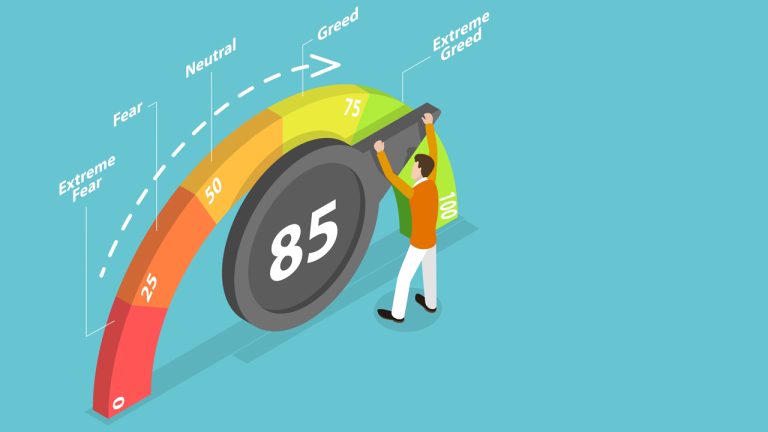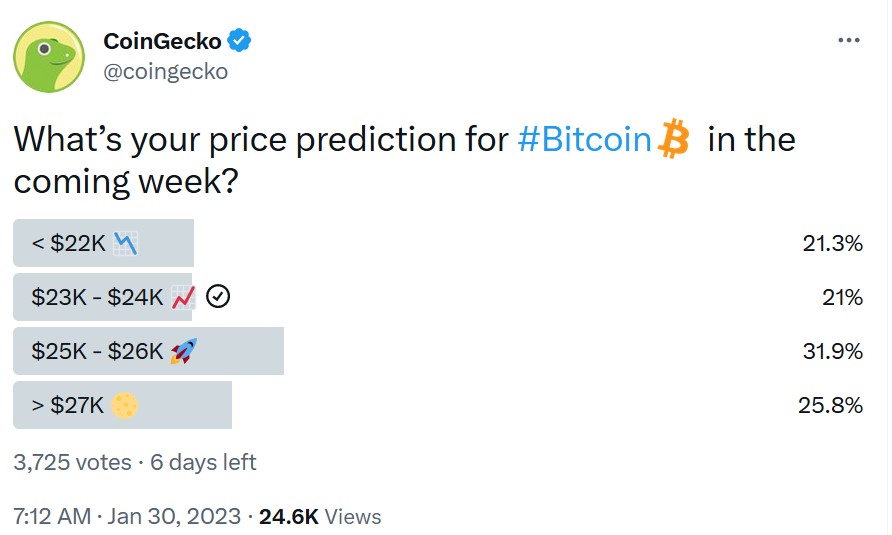 This week, 2,600 tech industry moguls and entrepreneurs, including Elon Musk, Gary Marcus, and Steve Wozniak, signed an open letter requesting artificial intelligence (AI) labs to pause research and development for six months. The signatories believe that safety programs and regulations need to be strengthened, as they assert that AI labs are currently in an […]
This week, 2,600 tech industry moguls and entrepreneurs, including Elon Musk, Gary Marcus, and Steve Wozniak, signed an open letter requesting artificial intelligence (AI) labs to pause research and development for six months. The signatories believe that safety programs and regulations need to be strengthened, as they assert that AI labs are currently in an […] Last month, statistics showed that the Crypto Fear and Greed Index (CFGI) had a score of 25, indicating “extreme fear.” Thirty days later, with a 39% increase in bitcoin prices against the U.S. dollar, the current CFGI score on Jan. 30, 2023, is 61, reflecting “greed.” Crypto Fear Index Jumps to ‘Greed,’ Etoro Market Analyst […]
Last month, statistics showed that the Crypto Fear and Greed Index (CFGI) had a score of 25, indicating “extreme fear.” Thirty days later, with a 39% increase in bitcoin prices against the U.S. dollar, the current CFGI score on Jan. 30, 2023, is 61, reflecting “greed.” Crypto Fear Index Jumps to ‘Greed,’ Etoro Market Analyst […]
Bitcoin's huge price surge in January has meant that 64% of Bitcoin investors are in profit, according to data from IntoTheBlock.
Bitcoin (BTC) has just clocked its 11th consecutive day outside the “Fear” zone in the Crypto Fear and Greed Index, cementing its longest streak out of fear since last March.
Bitcoin Fear and Greed Index is 61 - Greed
— Bitcoin Fear and Greed Index (@BitcoinFear) January 30, 2023
Current price: $23,780 pic.twitter.com/U5gxN3AwnT
This comes as Bitcoin hit $23,955 at 8:10 pm UTC time on Jan. 29, its highest level of the year. It has since come back down slightly, to $23,687 at the time of writing.
Meanwhile, Bitcoin sentiment is currently sitting firmly in the “Greed” zone with a score of 61, its highest level since the height of the bull run around Nov. 16, 2021, when its price was about $65,000.

However, despite Bitcoin’s strong resurgence in recent weeks, market participants continue to debate whether the recent price surge is part of a bull trap or whether there is a real chance for a bull run.
Regardless, the current rally has pushed a lot more BTC holders back into the green.
According to data from blockchain intelligence platform IntoTheBlock, 64% of Bitcoin investors are now in profit.
Those who first bought BTC back in 2019 are now — on average — back in profit too, according to on-chain analytics platform Glassnode.
We can calculate the average acquisition price for #Bitcoin by tracking exchange withdrawals.
— glassnode (@glassnode) January 29, 2023
The chart below shows the average withdrawal price for investors for each year.
The average class of 2019+ $BTC is now back in profit (at $21.8k)
Live Chart: https://t.co/yuhvydV70c pic.twitter.com/skjrM6w5lH
The average first-time buy price for BTC investors in 2019 was $21,800, which means those investors are on average up about 9% at the Jan. 29 price of $23,687.
Related: Bitcoin eyes $25K as BTC price nears best weekly close in 5 months
Meanwhile, a Jan. 29 poll from crypto market platform CoinGecko has revealed that 57.7% of 3,725 voters believe BTC will exceed $25,000 this week, while only 21.2% of voters believe BTC is primed for a pullback below $22,000.

The founder and CEO of Vailshire Capital, Dr. Jeff Ross, also provided a technical analysis of his own on Jan. 29, suggesting that a price surge toward $25,000 in the short term may be on the cards:
The strength of #bitcoin on the 4-hour charts continues to be impressive.
— Dr. Jeff Ross (@VailshireCap) January 29, 2023
While price action has trended sideways for over a week, short term indicators (MACD, RSI) have once again reset... and are now ramping higher.
A price surge to ~$25k is probable.
(Not investment advice) pic.twitter.com/QaPbNrxtxZ
Other analysts have called for excited investors to taper some of their expectations, however.
Head analyst Joe Burnett of Bitcoin mining company Blockware told his 43,900 Twitter followers on Jan. 29 that BTC won’t reach and surpass its all-time high of $69,000 until after the next Bitcoin halving event, which is expected to take place in March 2024:
I do not think Bitcoin will make a new all time high until after the 2024 halving.
— Joe Burnett ()³ (@IIICapital) January 29, 2023
Dovish macro conditions and decreased miner sell pressure will lead to the next parabolic bull run.
Using Energy Gravity as a potential top indicator, I expect the next peak to be $150k - $350k. pic.twitter.com/OfCER7s8Zq
Macroeconomist and investment adviser Lyn Alden also recently told Cointelegraph that there may be “considerable danger ahead” with potentially risky liquidity conditions expected to shake the market in the second half of 2023.

CoinList blamed “custodian issues” with one suffering an outage affecting “many tokens” on the platform as the reason for reported withdrawal problems.
Cryptocurrency exchange and Initial Coin Offering (ICO) platform CoinList took to Twitter to address “FUD” after a blogger tweeted that users reported being unable to withdraw funds for over a week, sparking fears the company was having liquidity issues or w insolvent.
“There is a lot of FUD going around that we would like to address head-on,” CoinList said in a Nov. 24 Twitter thread that stated the exchange is “not insolvent, illiquid, or near bankruptcy.” It said however that its deposits and withdrawals are affected by “technical issues.”
2/ We are upgrading our internal ledger systems and are migrating wallet addresses involving multiple custodians.
— CoinList (@CoinList) November 24, 2022
This is one of many efforts we are undertaking to offer our customers around the world better products and services while maintaining compliance.
Crypto-focused blogger Colin Wu had earlier tweeted to his 245,000 followers that “some community members” using CoinList have been unable to withdraw for over a week due to maintenance.
CoinList has a $35 million creditor claim with bankrupt crypto hedge fund Three Arrows Capital which Wu said in his tweet was a “loss,” that likely triggered concerns the company was insolvent or illiquid.
Looking to dampen fears that have seen bank runs on other platforms, CoinList explained that an upgrade to its internal systems and a migration of wallet addresses that involves “multiple custodians” is being undertaken.
The company cited unexplained “custodian issues” as the reason a selection of cryptocurrencies “are taking longer than anticipated to migrate” with one of its unnamed custodian partners suffering from an “outage [...] unrelated to the migration” on Nov. 23 which impacted tokens on the platform.
Its status page shows “degraded performance” for withdrawals, with four cryptocurrencies unavailable for withdrawal since Nov. 15, and one experiencing delayed deposits since Nov. 16.
“Once again, this is purely a technical issue, not a liquidity crunch,” CoinList said. It claimed to hold “all user assets dollar for dollar” and noted it plans to publish its proof of reserves.
Cointelegraph has contacted CoinList for more information but did not immediately receive a response.
Related: FTX illustrated why banks need to take over cryptocurrency
CoinList claimed on Nov. 14 that it had no exposure to the now-bankrupt FTX exchange, but users are increasingly nervous about centralized platforms and have rushed to ensure safe custody of their assets as evidenced by the surge in sales reported in mid-November by hardware wallet providers Trezor and Ledger.
Around the same time, outflows of Bitcoin (BTC) and stablecoins from exchanges hit historic highs and a corresponding uptick in activity was seen on decentralized exchanges.
 Bitpreco, a Brazilian cryptocurrency exchange, has decided to extend its functionality to offer banking services through a new platform called Bitybank. The company, which will also open payment and digital account services, plans to attract users to crypto through cashback programs that counter the fears of users purchasing cryptocurrencies in today’s uncertain market. Bitpreco to […]
Bitpreco, a Brazilian cryptocurrency exchange, has decided to extend its functionality to offer banking services through a new platform called Bitybank. The company, which will also open payment and digital account services, plans to attract users to crypto through cashback programs that counter the fears of users purchasing cryptocurrencies in today’s uncertain market. Bitpreco to […]
BTC bulls were liquidated in last week’s drop to $20,800, meaning even more downside could occur if this level fails ahead of this week’s $1 billion options expiry.
Bitcoin (BTC) experienced a 16.5% correction between Aug. 15 and Aug. 19 as it tested the $20,800 support. While the drop is startling, in reality a $4,050 price difference is relatively insignificant, especially when one accounts for Bitcoin's 72% annualized volatility.
Currently, the S&P 500’s volatility stands at 31%, which is significantly lower, yet the index traded down 9.1% between June 8 and June 13. So, comparatively speaking, the index of major U.S. listed companies faced a more abrupt movement adjusted for the historical risk metric.
At the start of this week, crypto investors' sentiment worsened after weaker conditions in Chinese real estate markets forced the central bank to reduce its five-year loan prime rate on Aug. 21. Moreover, a Goldman Sachs investment bank strategist stated that inflationary pressure would force the U.S. Federal Reserve to further tighten the economy, which negatively impacts the S&P 500.
Regardless of the correlation between stocks and Bitcoin, which is currently running at 80/100, investors tend to seek shelter in the U.S. dollar and inflation-protected bonds when they fear a crisis or market crash. This movement is known as a "flight to quality" and tends to add selling pressure on all risk markets, including cryptocurrencies.
Despite the bears' best efforts, Bitcoin has not been able to break below the $20,800 support. This movement explains why the $1 billion Bitcoin monthly options expiry on Aug. 26 could benefit bulls despite the recent 16.5% loss in 5 days.
Bitcoin's steep correction after failing to break the $25,000 resistance on Aug. 15 surprised bulls because only 12% of the call (buy) options for the monthly expiry have been placed above $22,000. Thus, Bitcoin bears are better positioned even though they placed fewer bets.

A broader view using the 1.25 call-to-put ratio shows more bullish bets because the call (buy) open interest stands at $560 million against the $450 million put (sell) options. Nevertheless, as Bitcoin currently stands below $22,000, most bullish bets will likely become worthless.
For instance, if Bitcoin's price remains below $22,000 at 8:00 am UTC on Aug. 26, only $34 million worth of these put (sell) options will be available. This difference happens because there is no use in the right to sell Bitcoin below $22,000 if it trades above that level on expiry.
Below are the four most likely scenarios based on the current price action. The number of options contracts available on Aug. 26 for call (bull) and put (bear) instruments varies, depending on the expiry price. The imbalance favoring each side constitutes the theoretical profit:
This crude estimate considers the call options used in bullish bets and the put options exclusively in neutral-to-bearish trades. Even so, this oversimplification disregards more complex investment strategies.
Bitcoin bulls need to push the price above $22,000 on Aug. 26 to balance the scales and avoid a potential $140 million loss. However, Bitcoin bulls had $210 million worth of leverage long futures positions liquidated on Aug. 18, so they are less inclined to push the price higher in the short term.
With that said, the most probable scenario for Aug. 26 is the $22,000 to $24,000 range providing a balanced outcome between bulls and bears.
If bears show some strength and BTC loses the critical $20,800 support, the $140 million loss in the monthly expiry will be the least of their problems. In addition, the move would invalidate the previous $20,800 low on July 26, effectively breaking a 7-week-long ascending trend.
The views and opinions expressed here are solely those of the author and do not necessarily reflect the views of Cointelegraph. Every investment and trading move involves risk. You should conduct your own research when making a decision.
 After the Crypto Fear and Greed Index (CFGI) dropped to significant lows and pointed to “extreme fear” in crypto markets at the end of May, and throughout most of June, today the CFGI rating is still in the “fear” zone, but it has seen an improvement. On June 19, the CFGI rating tapped a low […]
After the Crypto Fear and Greed Index (CFGI) dropped to significant lows and pointed to “extreme fear” in crypto markets at the end of May, and throughout most of June, today the CFGI rating is still in the “fear” zone, but it has seen an improvement. On June 19, the CFGI rating tapped a low […]
The total crypto market capitalization is rising toward $1.25 trillion, but an assortment of metrics show retail and institutions are not ready to “ape.”
An ascending triangle formation has driven the total crypto market capitalization toward the $1.2 trillion level. The issue with this seven-week-long setup is the diminishing volatility, which could last until late August. From there, the pattern can break either way, but Tether and futures markets data show bulls lacking enough conviction to catalyze an upside break.

Investors cautiously await further macroeconomic data on the state of the economy as the United States Federal Reserve (FED) raises interest rates and places its asset purchase program on hold. On Aug. 12, the United Kingdom posted a gross domestic product (GDP) contraction of 0.1% year-over-year. Meanwhile, inflation in the U.K. reached 9.4% in July, the highest figure seen in 40 years.
The Chinese property market has caused the Fitch Ratings credit agency to issue a “special report” on Aug. 7 to quantify the impact of prolonged distress on a potentially weaker economy in China. Analysts expect asset management and smaller construction and steel-producing companies to suffer the most.
In short, risk asset investors are anxiously waiting for the Federal Reserve and Central Banks across the world to signal that the policy of tightening is coming to an end. On the other hand, expansionary policies are more favorable for scarce assets, including cryptocurrencies.
The risk-off attitude caused by increased interest rates has instilled a bearish sentiment into cryptocurrency investors since mid-April. As a result, traders have been unwilling to allocate to volatile assets and sought shelter in U.S. Treasuries, even though their returns do not compensate for inflation.

The Fear and Greed Index hit 6/100 on June 19, near the lowest ever reading for this data-driven sentiment gauge. However, investors moved away from the “extreme fear” reading during August as the indicator held a 30/100 level. On Aug. 11, the metric finally entered a “neutral” area after a fou-month-long bearish trend.
Below are the winners and losers from the past seven days as the total crypto capitalization increased 2.8% to $1.13 trillion. While Bitcoin (BTC) presented a mere 2% gain, a handful of mid-capitalization altcoins jumped 13% or more in the period.

Celsius (CEL) jumped 97.6% after Reuters reported that Ripple Labs displayed interest in acquiring Celsius Network and its assets which are currently under bankruptcy.
Chainlink (LINK) rallied 17% after announcing on Aug. 8 that it would no longer support the upcoming Ethereum proof-of-work (PoW) forks that occur during the Merge.
Avalanche (AVAX) gained 14.6% after being listed for trading on Robinhood on Aug. 8.
Curve DAO (CRV) lost 6% after the nameserver for the Curve.Fi website was compromised on Aug 9. The team quickly addressed the problem, but the front-end hack caused some of its users' losses.
The OKX Tether (USDT) premium is a good gauge of China-based retail crypto trader demand. It measures the difference between China-based peer-to-peer (P2P) trades and the United States dollar.
Excessive buying demand tends to pressure the indicator above fair value at 100% and during bearish markets Tether’s market offer is flooded and causes a 4% or higher discount.

On Aug. 8, the Tether price in Asia-based peer-to-peer markets entered a 2% discount, signaling moderate retail selling pressure. More importantly, the metric has failed to improve while the total crypto capitalization gained 9% in 10 days, indicating weak demand from retail investors.
To exclude externalities specific to the Tether instrument, traders must also analyze futures markets. Perpetual contracts, also known as inverse swaps, have an embedded rate that is usually charged every eight hours. Exchanges use this fee to avoid exchange risk imbalances.
A positive funding rate indicates that longs (buyers) demand more leverage. However, the opposite situation occurs when shorts (sellers) require additional leverage, causing the funding rate to turn negative.

Perpetual contracts reflected a neutral sentiment after Bitcoin and Ether held a slightly positive (bullish) funding rate. The current fees imposed on bulls are not concerning and resulted in a balanced situation between leveraged longs and shorts.
According to derivatives and trading indicators, investors are less inclined to increase their positions at current levels, as shown by the Tether discount in Asia and the absence of a positive funding rate in futures markets.
These neutral-to-bearish market indicators are worrisome, given that total crypto capitalization has been in a seven-week uptrend. Investors’ distress over Chinese property markets and further FED tightening movements is the most likely explanation.
For now, the odds of the ascending triangle breaking above the projected $1.25 trillion mark seem low, but further macroeconomic data is needed to estimate the direction central banks might take.
The views and opinions expressed here are solely those of the author and do not necessarily reflect the views of Cointelegraph. Every investment and trading move involves risk. You should conduct your own research when making a decision.

A key derivatives metric used by margin traders has hit a record-high, but there’s plenty of risk and a catch to consider.
Bitcoin (BTC) has been unable to close above $32,000 for the past 28 days, frustrating bulls and pushing the Fear and Greed index to bearish levels below 10. Even with June 6’s small boost, the tech-heavy Nasdaq stock market index is down 24% year-to-date.
Investors who keep a close eye on regulatory development were possibly scared after New York state made clear its intention to regulate the crypto industry, including Bitcoin mining.
On June 2, New York Attorney General Attorney Letitia James issued an investor alert against "risky cryptocurrency investments," citing the assets' volatility. According to Cointelegraph, the attorney general is convinced that crypto investments create "more pain than gain" for investors.
The New York State Senate approved a proof-of-work (PoW) mining ban on June 2 and the proposed controversial bill aims to prohibit any new mining operations in the state for the next two years and is now headed for the governor's desk.
Interestingly, as all of this takes place, Bitcoin derivatives traders have never been so bullish, according to one metric.
Margin trading allows investors to leverage their positions by borrowing stablecoins and using the proceeds to buy more cryptocurrency. When those savvy traders borrow Bitcoin, they use the coins as collateral for shorts, meaning they are betting on a price decrease.
That is why some analysts monitor the total lending amounts of Bitcoin and stablecoins to gain insight into whether investors are leaning bullish or bearish. Interestingly, Bitfinex margin traders entered their highest ever leverage long (bull) position on June 6.

Bitfinex margin traders are known for creating position contracts of 20,000 BTC or higher in a very short time, indicating the participation of whales and large arbitrage desks.
Notice that the longs (bull) indicator vastly increased in mid-May and currently stands at 90,090 BTC contracts, its highest-ever registry. To understand how severe this movement was, one might compare it to the June–July 2021 previous all-time high of 54,500 BTC contracts in longs.
These traders hit the bullseye as their bullish positions peaked right as Bitcoin price bottomed. Over the subsequent months, they could sell those long (bull) contracts at a profit, reducing the number of open long positions (blue line).
One might assume that these whales and arbitrage desks trading at Bitfinex margin markets have better timing (or knowledge), and thus it makes sense to follow their steps. However, if we analyze the same metric for 2019 and 2020, a completely different scenario emerges.

There were three hikes in the number of Bitfinex BTC margin longs this time around. The first instance happened between mid-November and mid-December 2019 after the indicator jumped from 25,200 BTC to 47,600 BTC longs. However, over the next month, the Bitcoin price failed to break above $8,300 and these traders closed their positions with minimal gains.
The next wave of BTC longs took place in early-February 2020, but those traders were caught by surprise after the Bitcoin price failed to break $10,500, forcing them to close their margin positions at a considerable loss.
Bitfinex BTC margin longs increased from 22,100 to 35,700 contracts in late-July 2020. The movement coincided with the price rally to $47,000, so the early entrants might have scored some profit, but most of the investors exited their margin longs with no gains.
To put things in perspective, over the previous four instances where BTC margin longs (bulls) significantly increased, investors had 1 profitable trade, 2 mostly neutral, and 1 considerable loss.
Some might say odds still favor those tracking the indicator, but one must remember that whales and arbitrage desks could easily crash the market when closing their positions. In such cases, those following the strategy might arrive late to the party and come out at a loss.
Will the current Bitfinex margin longs increase result in extreme profits? It might depend on how traditional markets, mainly tech stocks, perform over the next couple of weeks.
The views and opinions expressed here are solely those of the author and do not necessarily reflect the views of Cointelegraph. Every investment and trading move involves risk. You should conduct your own research when making a decision.
 For a few weeks now, bitcoin sentiment stemming from the Crypto Fear and Greed Index (CFGI) has been in the “extreme fear” range. While bitcoin gathered some gains on Monday, the CFGI is still in the “extreme fear” position with a ranking score of 16 out of 100. Crypto Fear and Greed Index Remains in […]
For a few weeks now, bitcoin sentiment stemming from the Crypto Fear and Greed Index (CFGI) has been in the “extreme fear” range. While bitcoin gathered some gains on Monday, the CFGI is still in the “extreme fear” position with a ranking score of 16 out of 100. Crypto Fear and Greed Index Remains in […]